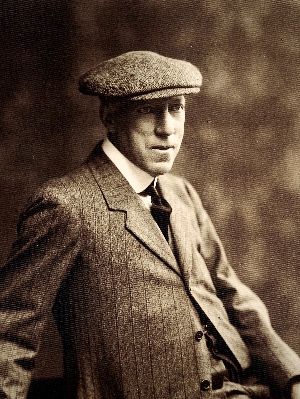Marshall, Miss Helen
Dancer
Collection date: Mar 1911
Area: Cumbria
Miss Helen Blanche Marshall (1866-1946) for two Keswick dances: Miss Marshall was present at the meeting with Sharp and Mr JT Southworth at Keswick on Sat 4 March 1911 when the dances imported from Mawdesley* were discussed and perhaps demonstrated by children. She made a particular comment about dance costume, which Sharp wrote into his Folk Dance Notes vol2/p18. She was crucial to the meeting because she had helped to train the Keswick schoolchildren to do these Mawdesley dances and had taken them out to perform them at local festivals. Sharp was possibly more interested in the original (adult) Lancashire dances rather than the children's versions but he did spend considerable time and effort at the Keswick school.
*Mawdesley is near Preston in Lancashire, approx 100 miles south of Keswick. See JT Southworth's profile under 'Lancashire' area.
It is Miss Marshall's handwriting and her initials HBM on the dance notation notes that Roy Smith reproduced in his article ‘Mawdesley’s Morris Dancers Remembered’ (Morris Dancer vol IV no.2 May 2010 pp28-33) https://themorrisring.org/sites/default/files/docs/mdancer/volume-4-number-2.pdf. These notes indicate that Marshall obtained the two Mawdesley dances (the processional or ‘Road Dance’ and the stationary or ‘Stage Dance’) from J Southwaite (sic) in November 1909. These dances were specifically to be used at the Keswick May Day Festivals** (or similar processional event).
A few points about Miss Marshall’s notation of the Mawdesley’s dances:
1.She uses and seems acquainted with Sharp’s choreographic shorthand symbols < and > to indicate movements. This would suggest she already had a copy of his (first) Morris Book, published in 1907. The Esperance instructional book did not come out till Mar 1910 and did not use these symbols.
2.Sharp took his own ‘live’ notes of aspects of the dancing he witnessed on 4 Mar 1911 (field notebook words 1910/4 pp50-56) and there is understandable agreement between much of his notation and that of Miss Marshall’s notes. Indeed Sharp appears to have paid Miss Marshall the compliment of actually copying her diagram of Figure 4 (Folk Dance Notes vol2 p24).
3.Miss Marshall’s actual use of the Mawdesley dances is not easy to trace. Having acquired them in Nov 1909, she probably first used the dances at the next Band of Hope May Festival on 5 May 1910. The West Cumberland Times (May 7th) described that in poor weather the May Queen processed through the town with her retinue of 17 maids of honour, followed by a ‘contingent of smart morris dancers’. Then came the flag bearers of the nine Bands of Hope from the Keswick wider district – in all some 500 children. A stage was in place for the braiding of the Maypole and then further morris dancing took place (presumably the Mawdesley ‘Stage Dance’). The following year (1911) the whole procession was cancelled due to unending rain and hail!
Note: The dance notations provided by the Morris Federation http://notation.apps.morrisfed.org.uk/document-library/north-west-morris for the two Keswick dances appear in typed format - they are the result of Roy Dommett’s researches. The ‘Stage Dance’ notes are said to have been collected by Mary Neal and Clive Carey on a visit to Keswick but these notes are not extant among their papers today and there are no newspaper reports of any visit by them. So, it is not certain when they might have visited Keswick. Clive Carey was not involved with the Esperance Club till summer 1910 and Mary Neal was in America between Dec 1910 and April 1911. Carey's morris collecting was mostly done in 1913, so the window for a visit was a small one.
Helen Blanche Marshall was born in 1866, 3rd of 9 daughters (+ 1 sibling brother) of Reginald Dykes Marshall, linen manufacturer of Leeds, and his wife Mary. Reginald’s father John Marshall had also been a linen manufacturer, whose wealth paid for the building of St John’s church, Keswick in 1838. Reginald was a JP for West Yorkshire for many years and purchased Castlerigg Manor in Keswick in 1888. Although he died in 1913, the family had a commitment to Keswick that lasted until Mary Marshall died in 1925 and the manor house was sold.
Helen Marshall had a German governess and learned to play piano well enough to accompany choirs and dancers at public concerts and events. Indeed she conducted choirs at musical festivals, selecting and arranging material. She was never a member of the teaching staff at St John’s school for girls but worked closely with Miss Frances Hayes, the headmistress. As a wealthy local benefactor, she no doubt paid for the travelling expenses for Mr Southworth to visit Keswick and transmit his dances.
Helen Blanche Marshall died July qr 1946 (Cockermouth 1a 68, aged 81)
** For the history of the Keswick May Day Festivals which began in 1885, see article 'Merrie England, May Day and more' by Dr Sue Allan in ‘The Histories of the Morris in Britain’ (ed Michael Heaney EFDSS 2018 pp179-201)https://media.efdss.org/docs/HOM/HOM%20Allan%20Merrie%20England%20Cumbria.pdf
See also profiles of Miss Frances Hayes and Mr Richard Clayton

